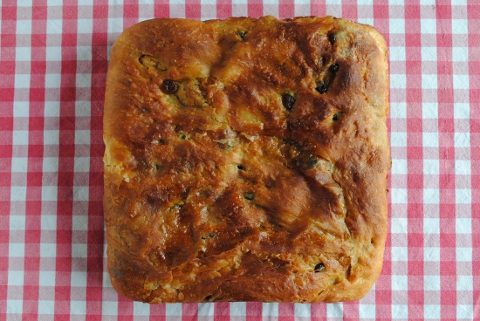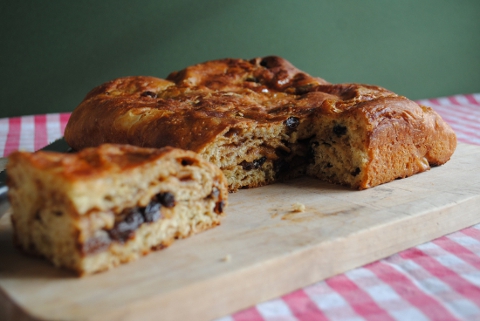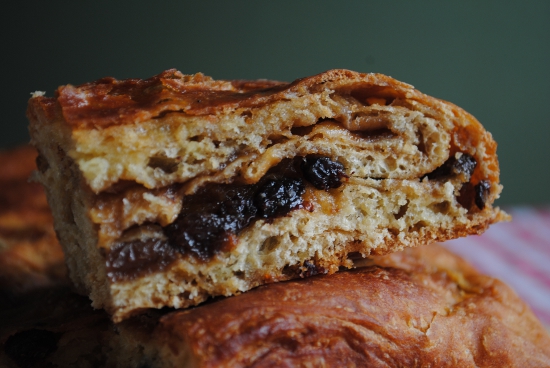Lard, larder, lardy
Lardy cake is one of the jewels in the crown of British baking, yet you would have your work cut out to find a bakery that could sell you one these days. There are variations of the lardy across the country, but it is most strongly associated with the westcountry and it was my father, Somerset born and bred, who introduced me to it.

As the name suggests, lardies are traditionally made with pork lard, using a rich dough made with milk and egg. The lardy is an example of a bread made using a laminated dough, which is to say that the dough is rolled and folded several times into thin sheets separated by a layer of hard fat so that the resulting layers separate during baking. The pinnacle of the art of the laminated dough is the French croissant. The lardy, on the other hand, is far less delicate and the purpose of the layers is to create gooey pockets of caramelised dried fruit throughout the dough. You can substitute butter for lard, or use a combination of the two. Purists might frown, but I tend to use butter as I prefer the flavour.

The recipe I use is one I’ve adapted from Linda Collister’s The Bread Book. I have reduced the amount of fat, sugar and fruit in the recipe, not out of concern for my health but because I just found it impossible to incorporate any more into the relatively small quantity of dough. Apart from being messy and wasteful, overstuffing the dough won’t do anything to help it rise.
250g strong white flour
110g milk
1 egg, beaten
5g salt
15g fresh yeast/7g fast action or easy blend
90g lard, butter, or a combination of the two, diced
90g sugar (any kind will do but I favour soft brown)
90g mixed currants and sultanas
Use the flour, milk, egg, salt and yeast to make a dough. Knead for five minutes and leave to bulk ferment for about an hour. The dough will be fairly sticky, but should quickly become smoother and easier to work as you begin to knead.
After bulk fermentation comes the complicated bit. Turn the dough out onto a floured surface and roll the dough out into a rectangle. The exact dimensions aren’t critical, but in order to incorporate the remaining ingredients it needs to be roughly 25cm by 15cm. Dough doesn’t roll out well because of its elastic nature, so be forceful and use short, rapid movements.
Now cover two thirds of your rectangle with a third of the fat, sugar and fruit. Don’t worry (as I tend to do) about arranging the ingredients with geometrical precision. This leaves you with a third of the dough uncovered. Fold this third over the middle third, then fold the remaining third over the top of that. Making the last fold is a bit messy, so it helps to gently press the additional ingredients into the dough to minimise spillage.
Seal the edges of the dough parcel with your fingers, turn it a quarter and roll it out into a rectangle, just like before. Repeat the process with the second third of the fat, sugar and fruit, turn the parcel another quarter and repeat a third time. It isn’t as difficult as it might sound.
You can use a round or square cake tin (preferably non-stick) to bake the cake; just roll the dough roughly to size and shape or use your fingers to press it into the tin to prove for an hour. Bake in an oven pre-heated to 230°c for 20-30 minutes until well browned.

Lardy cakes are best eaten within a couple of days, but they freeze well. You could also tweak the formula: try macerating the dried fruit in brandy or adding cinnamon to the filling. Don’t overdo it, though – less is usually more.
